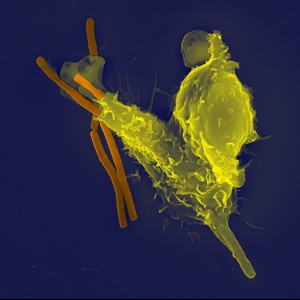
Encyclopedia: Immune System
The immune system is composed of white blood cells, the proteins they produce, and their actions in defending the body.
The innate immune system is in place to combat new threats, while the adaptive immune system is developed against specific, previously encountered threats.
The bulk of the immune system originates in the bone marrow. Groups of lymphocytes are found in the peripheral lymph nodes, tonsils, Peyer's patches, and other locations.
The spleen is another central immune tissue, involved in surveillance. The thymus is important in early T cell development.
Cells and Molecules of the immune system
- innate immune system
- adaptive immune system
Innate Immune System
Innate immunity provides the first line of defense against infection. Most of its components are present before infection and represent a set of disease-resistance mechanisms that are not specific to particular threats.
The skin provides a mechanical barrier of entry of microbes, while its low pH (3-5) slows microbial growth. Mucous membranes are covered with normal flora that competes with pathogens, while mucus traps organisms and cilia propel them from the body. Temperature and various soluble and cell-surface molecules contribute to innate immunity by impeding the growth of certain pathogens.
Inflammation is a key innate response to invasion. The systemic, or acute phase response, includes fever and release of serum proteins to increase host immunity.
Phagocytic cells are responsible for ingesting pathogens and debris.
- neutrophils: the first line of defence against pathogens
- macrophages/monocytes: other phagocytic cells, responsible for ongoing clearing of pathogens and debris.
Other important cells of the innate immune system include:
- mast cells
- eosinophils
Many of the molecules involved in innate immunity use pattern recognition to detect classes of molecules found on pathogens, such as lipopolysaccharides.
Adaptive immune system
Adaptive immunity is responsible for the selective recognition and elimination of pathogens and molecules the body has previously seen. It is characterized by antigen specificity, diversity, immunologic memory, and self/non-self recognition.
An effective response involves two cell types - lymphocytes and antigen presenting cells.
Antigen-presenting cells include:
Lymphocytes are responsible for developed immunity.
further information
T cells arise in the bone marrow and mature in the thymus gland. During maturation they express a unique antigen-binding molecule, the T Cell Receptor (TCR).
- CD 4+ cells: help orchestrate the adaptive immune system
- CD 8+ cells: important effectors, especially against viruses and cancers
- natural killer cells
- double negative T cells
B lymphocytes/plasma cells: produce immunoglobulins (antibodies).
Immune-mediated Responses
To sort...
- response to viral infection
- response to bacterial activation
- response to parasite activation
- response to fungal activation

